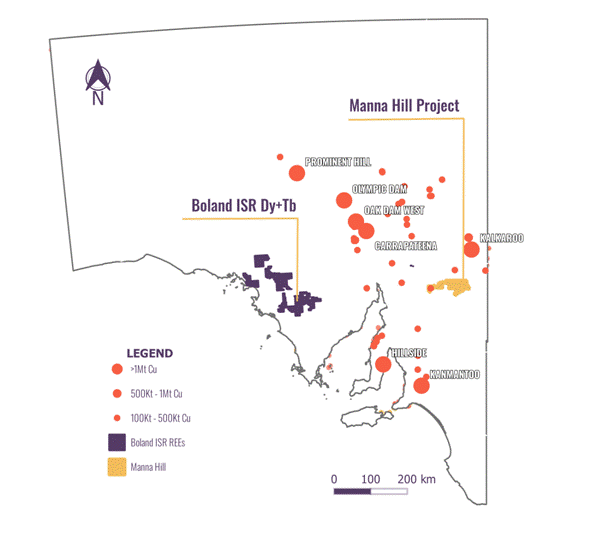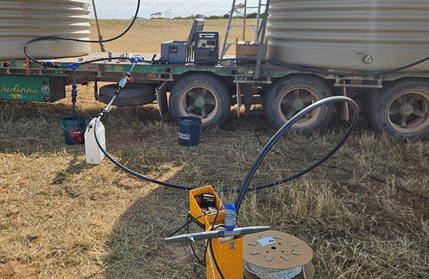
THIS ANNOUNCEMENT CONTAINS INSIDE INFORMATION FOR THE PURPOSES OF ARTICLE 7 OF REGULATION 2014/596/EU WHICH IS PART OF DOMESTIC UK LAW PURSUANT TO THE MARKET ABUSE (AMENDMENT) (EU EXIT) REGULATIONS (SI 2019/310) ("UK MAR"). UPON THE PUBLICATION OF THIS ANNOUNCEMENT, THIS INSIDE INFORMATION (AS DEFINED IN UK MAR) IS NOW CONSIDERED TO BE IN THE PUBLIC DOMAIN.
NOT FOR RELEASE, PUBLICATION OR DISTRIBUTION, IN WHOLE OR IN PART, DIRECTLY OR INDIRECTLY IN OR INTO THE UNITED STATES, AUSTRALIA, CANADA, JAPAN, THE REPUBLIC OF SOUTH AFRICA OR ANY OTHER JURISDICTION WHERE TO DO SO WOULD CONSTITUTE A VIOLATION OF THE RELEVANT LAWS OF SUCH JURISDICTION.
29 October 2025
Cobra Resources plc
("Cobra" or the "Company")
In-Field Permeability Study Update
Commencement of Field Trials and Assignment of Native Title Mining Agreement for New Tenements
Cobra (LSE: COBR), a South Australian mineral exploration and development company, is pleased to announce that field trials have commenced at the Company's Boland Ionic Heavy Rare Earth Project in South Australia, where tests will emulate the low-cost and environmentally sustainable in-situ recovery ("ISR") mining method. Furthermore, a Deed of Assignment has been executed with the Barngarla Traditional Owners, enabling transfer of tenure of acquired Exploration Licences 6742, 6774, and 6780 (the "New Tenements") that contain three key scalable Palaeochannel hosted Rare Earth Elements ("REEs") targets.
Highlights
· Infield trials include:
· Hydrological tests to evaluate aquifer discharge rates
· Tracer permeability testing aimed to demonstrate orebody permeability and connectivity
· Trials are anticipated to take 7-14 days where tests aim to emulate permeability achieved in recent bench scale ISR studies that achieved 66% Heavy Rare Earth ("HREO") recoveries in 17 days, with very low acid consumption at pH 3
· Deed of Assignment executed, assigning the Native Title Mining Agreement ("NTMA") from the previous owner to Cobra and enabling the transfer of tenure
· Stakeholder engagement process commenced to proceed towards the testing of priority targets: Head, Gillespie and Stokes
Follow this link to watch a short video of Exploration Manager Robert Blythman explaining the trials from the site: https://investors.cobraplc.com/link/P3j6xr
The Boland Project is unique when compared to traditional ionic clay hosted REE deposits as REEs have been mobilised from underlying weathered granites (saprolite) and absorbed to fine organics within the Pidinga Formation, a highly permeable paleo-sediment confined by impermeable clays. This unique environment enables controlled ISR, the lowest cost and most sustainable form of mining.
Rupert Verco, Managing Director of Cobra, commented:
"We are thrilled to be executing these field studies. This is a very important step in advancing the Boland Project, with this testing aiming to demonstrate the lowest cost and most sustainable method of mining. Should these tests be successful, it will be another significant milestone achieved in Cobra's strategy to be a resilient, low-cost, environmentally sustainable and ethical producer of heavy rare earth metals, Dysprosium and Terbium.
We are also very pleased to have a NTMA in place with the Barngarla People for the New Tenements, where we have demonstrated high grades and massive scale potential. We look forward to working in collaboration with the Barngarla People, the landowners and the Wudinna community to advance this significant opportunity."
Figure 1. Rendement Principal Hydrologist Ben Jeuken installing a downhole pump in the Boland Wellfield and the pump test currently underway.
|
|
|
Boland Project
At Boland, Cobra has discovered what it believes to be a unique, scalable instance where ionic rare earth elements - containing economically attractive grades of valuable heavy and magnet rare earths - occur in a permeable horizon confined between horizons of impermeable clay.
Bench scale ISR testing has confirmed that this mineralisation is amenable to ISR recovery techniques. ISR techniques are currently in use (and have been used successfully for decades) in geologically similar environments, to recover uranium in South Australia which maintains a well-established ISR regulatory system.
Results of Cobra's ongoing mineral recovery test work indicate that, with minor optimisation, ISR techniques will enable non-invasive and low-cost production of critical REEs from its discovery at Boland.
Further information relating to Boland and these results are presented in the appendices.
Enquiries:
| Cobra Resources plc Rupert Verco (Australia) Dan Maling (UK)
| via Vigo Consulting +44 (0)20 7390 0234
|
| SI Capital Limited (Joint Broker) Nick Emerson Sam Lomanto
| +44 (0)1483 413 500
|
| Global Investment Strategy (Joint Broker) James Sheehan | +44 (0)20 7048 9437 james.sheehan@gisukltd.com |
| Vigo Consulting (Financial Public Relations) Ben Simons Fiona Hetherington | +44 (0)20 7390 0234 cobra@vigoconsulting.com |
The person who arranged for the release of this announcement was Rupert Verco, Managing Director of the Company.
About Cobra
Cobra Resources is a South Australian critical minerals developer, advancing assets at all stages of the pre-production pathway.
In 2023, Cobra identified the Boland ionic rare earth discovery at its Wudinna Project in the Gawler Craton - Australia's only rare earth project suitable for in situ recovery (ISR) mining. ISR is a low-cost, low-disturbance extraction method that eliminates the need for excavation, positioning Boland to achieve bottom-quartile recovery costs.
In 2025, Cobra further expanded its portfolio by optioning the Manna Hill Copper Project in the Nackara Arc, South Australia. The project contains multiple underexplored prospects with strong potential to deliver large-scale copper discoveries.
In 2025, Cobra sold its Wudinna Gold Assets to Barton Gold (ASX: BDG) for up to A$15 million in cash and shares.
Regional map showing Cobra's tenements in South Australia

Follow us on social media:
LinkedIn: https://www.linkedin.com/company/cobraresourcesplc
X: https://twitter.com/Cobra_Resources
Engage with us by asking questions, watching video summaries and seeing what other shareholders have to say. Navigate to our Interactive Investor hub here: https://investors.cobraplc.com/
Subscribe to our news alert service: https://investors.cobraplc.com/auth/signup
Appendix 1: Background information - the Boland Project and ISR
· The Boland Project was discovered by Cobra in 2023. Mineralisation is ionically bound to clays and organics within palaeochannel sands within the Narlaby Palaeochannel
· Mineralisation occurs within a permeable sand within an aquifer that is saltier than sea water and is confined by impermeable clays
· ISR is executed through engineered drillhole arrays that allow the injection of mildly acidic ammonium or magnesium sulphate lixiviants, using the confining nature of the geology to direct and lower the acidity of the orebody. This low-cost process enables mines to operate profitably at lower grades and lower rates of recovery
· Once REEs are mobile in solution in groundwater, it is also possible, from an engineering standpoint, to recover the solution to surface via extraction drillholes, without any need for excavation or ground disturbance
· The capital costs of ISR mining are low as they involve no material movements and do not require traditional infrastructure to process ore - i.e. metals are recovered in solution
· Ionic mineralisation is highly desirable owing to its high weighting of valuable HREOs and the cost-effective method in which REEs can be desorbed
· Ionic REE mineralisation in China is mined in an in-situ manner that relies on gravity to permeate mineralisation. The style of ISR process is unconfined and cannot be controlled, increasing the risk for environmental degradation. This low-cost process has enabled China to dominate mine supply of HREOs, supplying over 90% globally
· Confined aquifer ISR is successfully executed globally within the uranium industry, accounting for more than 60% of the world's uranium production. This style of ISR has temporary ground disturbance, and the ground waters are regenerated over time
· Cobra is aiming to demonstrate the economic and environmental benefits of recovering ionic HREOs through the more environmentally aquifer controlled ISR - a world first for rare earths
Figure A1: Comparison between the Chinese and the proposed Boland process for ISR mining of REEs

RNS may use your IP address to confirm compliance with the terms and conditions, to analyse how you engage with the information contained in this communication, and to share such analysis on an anonymised basis with others as part of our commercial services. For further information about how RNS and the London Stock Exchange use the personal data you provide us, please see our Privacy Policy.

